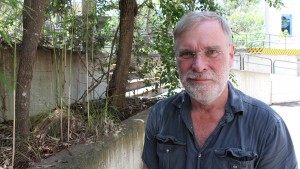Skeletal remains of a group of hunter-gatherers massacred around 10,000 years ago are raising questions about humankind’s propensity for warfare.
The fossilised bones of the Stone Age victims were unearthed at Nataruk — 30km west of Kenya’s fossil-rich Lake Turkana — and are believed to be the earliest scientifically dated historical evidence of human conflict.
The new Director of Griffith University’s Research Centre of Human Evolution, Professor Rainer Grün, was part of the Nataruk research team led by the University of Cambridge’s Leverhulme Centre for Human Evolutionary Studies (LCHES).
The site was discovered on the western side of Lake Turkana in 2012 when researchers found the partial remains of 27 individuals, including at least eight women and six children.
Of these, 12 skeletons were relatively complete and 10 revealed clear signs of violent death, including: extreme blunt-force trauma to crania and cheekbones; broken hands, knees and ribs; arrow lesions to the neck; and stone projectile tips lodged in the skull and thorax of two men.
Several skeletons were found face down, with four — including a woman in the final stages of pregnancy — in positions indicating their hands had probably been bound.
While the bodies were not buried, some had fallen into a lagoon that has long since dried, with the bones preserved in sediment.
The research is published in the latest edition of the prestigious journalNature.
“The findings are one of the earliest indications of humankind’s propensity for group violence,” said Professor Grün, who joined Griffith’s Environmental Futures Research Institute from the Australian National University in October. He used laser ablation technology to examine and date the fossils.
“Not only does this broaden our knowledge of early human behaviour, it raises questions about whether the capacity for organised violence is elemental to our nature or a product of circumstances and opportunity.”
One adult male skeleton was found with an obsidian bladelet still embedded in his skull. Another suffered two blows to the head, both crushing his skull at the point of impact.
Meanwhile, the remains of a six-to-nine month-old foetus were recovered from within the abdominal cavity of its mother, who was discovered in an unusual sitting position.

A woman, found reclining on her left elbow, with fractures on the knees and possibly the left foot. The position of the hands suggests her wrists may have been bound
Now scrubland, 10,000 years ago the area around Nataruk was a fertile lakeshore sustaining a substantial population of hunter-gatherers. It may also have been a location coveted by others.
Project leader Dr Marta Mirazon Lahr, from LCHES, said the victims may have been members of an extended family who were attacked by a rival group of hunter-gatherers in an ancient precursor to what we call warfare.
“The deaths at Nataruk are testimony to the antiquity of inter-group violence and war,” she said.
“These remains record the intentional killing of a small band of foragers with no deliberate burial, and provide unique evidence that warfare was part of the repertoire of inter-group relations among some prehistoric hunter-gatherers.”
Professor Robert Foley, also from Cambridge’s LCHES, summarised the implications of the research by saying: “I’ve no doubt it is in our biology to be aggressive and lethal, just as it is to be deeply caring and loving.
“A lot of what we understand about human evolutionary biology suggests these are two sides of the same coin.”
Watch the videohere

